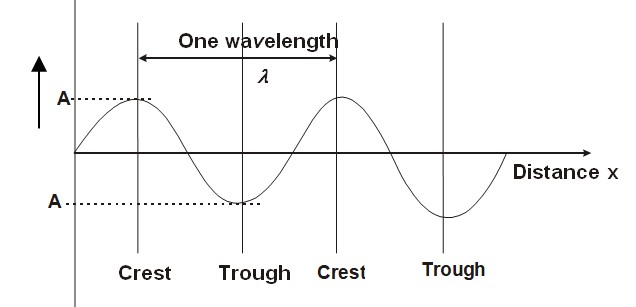“A wave is a disturbance produced in a medium which propagates with a definite speed without making any change in the medium”.
When a wave propagates the particles of the medium oscillates at their own position with frequency and amplitude that of the wave. During oscillation the particles transfer energy to the next particles of the medium.
Like this, the energy associated with the wave propagates in the medium, moving from one particle to the other and we say the wave is propagating. Thus, when wave propagates, along with the wave only the energy propagates.
Types of Waves
On the basis of their nature (propagation)
(a) Mechanical Wave:
The wave that needs material medium for its propagation is known as mechanical waves.
Mechanical waves are most familiar to us because we encounter them constantly; common examples include water waves, sound waves, seismic waves, etc. All these waves have certain central features: They are governed by Newton’s laws, and can exist only within a material medium, such as water, air, rock etc.
For propagation of wave (mechanical wave) through a medium there are two necessary conditions to be possessed by the medium.
(1) Elasticity (2) the particles of medium must have inertia.
(b) Electro- Magnetic Wave
The wave that doesn’t need material medium for its propagation is known as electromagnetic wave.
The common examples of electromagnetic waves are visible and ultraviolet light, radio waves, microwaves, x-rays etc. All electromagnetic waves travel through vacuum at the same speed c, given by c = 299,792,458 ms–1 (speed of light)
Unlike the mechanical waves, the electromagnetic waves do not require any medium for their propagation.
On the basis of vibration of particles
(a) Transverse wave:
If the particles of the medium oscillate perpendicular to the direction of propagation of wave, the wave is known as transverse wave.
Eg. Wave generated in a string. These can be generated only in solids.

The points of the medium at which the displacement of the particles of medium is maximum in positive , are known as position of crest. The points of the medium at which the particle of medium are in maximum displacement in negative, are known as position of trough. The position of crest and trough are not fixed. They change with time. At the same point in the medium the crest and troughs are formed attentively. The distance between two consecutive crest or between two consecutive trough, at a given instant, is known as wavelength of the wave.
(b) Longitudinal wave:
The wave in which the particles of the medium oscillate along the direction of propagation of wave is known as longitudinal wave. Eg. Sound .When a longitudinal wave propagates through a medium, at some places the particles come very close to each other and at some places the particles move away from each other. These positions are called compression and rarefaction respectively. At the position of compression the density, pressure and energy are maximum ,where as, at the position of rarefaction, the density pressure and energy are minimum.

Now let us consider the propagation of sound waves in air. As the sound passes through air, it compresses or expands a small region of air. This causes a change in the density of that region, say dr, this change induces a change in pressure, dp, in that region. Pressure is force per unit area, so there is a restoring force proportional to the disturbance, just like in a spring. If a region is compressed, the molecules in that region are packed together, and they tend to move out to the adjoining region, thereby increasing the density or creating compression in the adjoining region. Consequently, the air in the first region undergoes rarefaction. If a region is comparatively rarefied the surrounding air will rush in making the rarefaction move to the adjoining region. Thus, the compression or rarefaction moves from one region to another, making the propagation of a disturbance possible in air.

